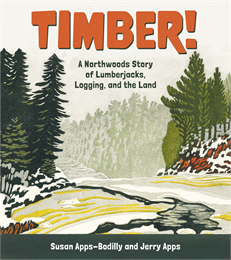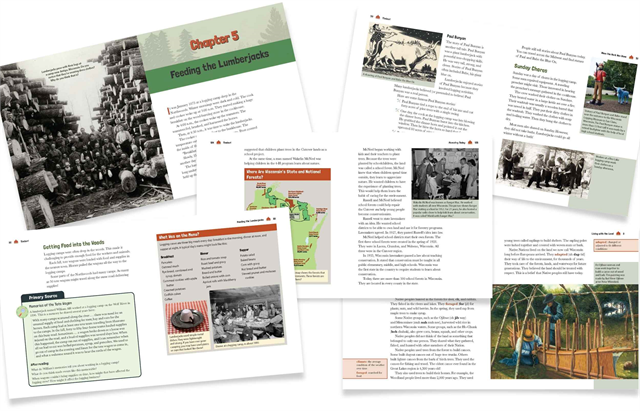Timber!
A Northwoods Story of Lumberjacks, Logging, and the Land

By Susan Apps-Bodilly and Jerry Apps
A children’s history of logging, land use, and the legacy of conservation
How did the logging boom begin? What was it like to work in the woods? What happened to the land after the trees were cut down? The latest book for young readers from father-daughter duo Jerry Apps and Susan Apps-Bodilly explores the origin story of Wisconsin’s logging boom, the devastation it caused to the land, and the extraordinary efforts to restore the cutover land and log sustainably.
Timber! helps young readers in grades 3–5 examine a complex and pivotal chapter in our state and nation’s history, covering a wide range of topics, including:
- how Native people used, shared, and relied on natural resources for thousands of years
- how the lumber industry made possible the westward expansion of the United States
- what it was like to work in a logging camp, on a log drive, and inside a sawmill
- the roles on a logging team, from sawyer to cook
- the legacy of early logging practices and early efforts to restore the land
- the emergence of sustainable forestry practices
This comprehensive yet easy-to-read history includes letters, postcards, and other primary sources paired with discussion questions designed to engage young readers’ creativity and critical-thinking skills. Timber! also features more than 100 images, a glossary, suggested activities, and an extensive list of related resources, including books, websites, teaching materials, museums, and outdoor places to visit. Timber! will inspire readers of all ages to explore, protect, and learn about trees and forests in their own communities.
Find Timber! at your favorite book retailer or in our online store.
ABOUT THE AUTHORS
Susan Apps-Bodilly is a retired elementary and middle-school educator. She is the author of One Room Schools: Stories from the Days of 1 Room, 1 Teacher, 8 Grades and Seeds in Soil: Planting a Garden and Finding Your Roots, as well as coauthor with Jerry Apps of Old Farm Country Cookbook, all published by the Wisconsin Historical Society Press.
Jerry Apps is a well-known rural historian and professor emeritus for the College of Agriculture and Life Science at the University of Wisconsin–Madison. He is the author of more than fifty books for adults and children, including Wisconsin Agriculture: A History; Garden Wisdom: Lessons Learned from 60 Years of Gardening; and When the White Pine was King: A History of Lumberjacks, Log Drives, and Sawdust Cities in Wisconsin, from which Timber! is loosely adapted. He and his wife, Ruth, divide their time between their home in Madison and their family tree farm, Roshara, in Waushara County.
AN INTERVIEW WITH SUSAN APPS-BODILLY
Much of the inspiration for Timber! came from Jerry Apps’s book When the White Pine Was King, which was written for adults. How did you translate those concepts and ideas into something kids can enjoy and understand?
Jerry had an extensive research process for When the White Pine Was King (published by the Wisconsin Historical Society Press in 2020). His research included both secondary sources and first-hand accounts of life in a lumber camp. He visited museums, read old letters and journals, and studied photographs from the time.
To translate these concepts for Timber!, we considered which topics would be most engaging for readers who have less prior knowledge of the subject. We included more details that kids are interested in, such as descriptions of the tools used by lumberjacks or what it was like to work in a sawmill. Timber! is written with an easy-to-read sentence structure and includes text elements that explain vocabulary for younger readers. There are also diagrams, maps, and sidebars that provide additional context. The book includes ways for readers to connect with primary sources such as photographs, letters, postcards, and journal entries. There are related activities and questions that encourage readers to think further about the topics covered. The book will be enjoyable to readers of all ages because it describes real people and real events.
This is the second book you and your dad have co-written. What was it like to work together? What did you learn from each other during the process of writing this book?
For Timber!, Jerry did the first draft, drawing from his book When the White Pine Was King and his vast knowledge of the subject matter. Then, I took that draft and rewrote it using my knowledge and expertise from years of teaching elementary and middle school. When there were difficult concepts or vocabulary, we talked about how best to write it so the younger reader would understand it. We went through several drafts and revisions, adding some things in and taking other things out. We wanted to be sure all the content, maps, photo captions, and sidebar descriptions were accurate.
I learned that Jerry’s research process is exhaustive and detailed. He is an expert in keeping track of his sources. Jerry says he learned that “Sue has a high level of curiosity for finding out the answers to questions and the discipline for getting the work done.”
What is something you learned while researching this project that you think will stand out to young readers?
I found the information about log drivers fascinating. After a winter’s work in a lumber camp, the best and most athletic folks stayed on as river drivers. Wearing spiked boots on their feet, they rode the floating logs on the river for many days to reach the mill. It was dangerous work, which required quick thinking and problem-solving. I also loved learning about reforestation efforts and how our state began sustainable forestry practices. Finally, I realized that the Menominee Forest (managed by the Menominee Nation) can be seen from outer space! I also learned that Menominee Tribal Enterprises supplied the basketball court flooring for the Milwaukee Bucks at the Fiserv Forum.
Timber! draws a lot of connections between the logging era and the present day. How do you hope the book will inspire young readers to think about and explore the world around them?
Learning about history helps kids understand people’s beliefs, values, and choices. It helps them think about how they want to live today and in the future. I hope readers of Timber! continue to research, ask questions, and use reliable sources to find answers. I hope they learn to protect and respect the natural world around them. The book has an appendix with many ideas to encourage young readers to be a steward for the trees. It describes ways to connect with nature and get outside. I dedicated this book to the next generations of young people responsible for caring for our forests.

